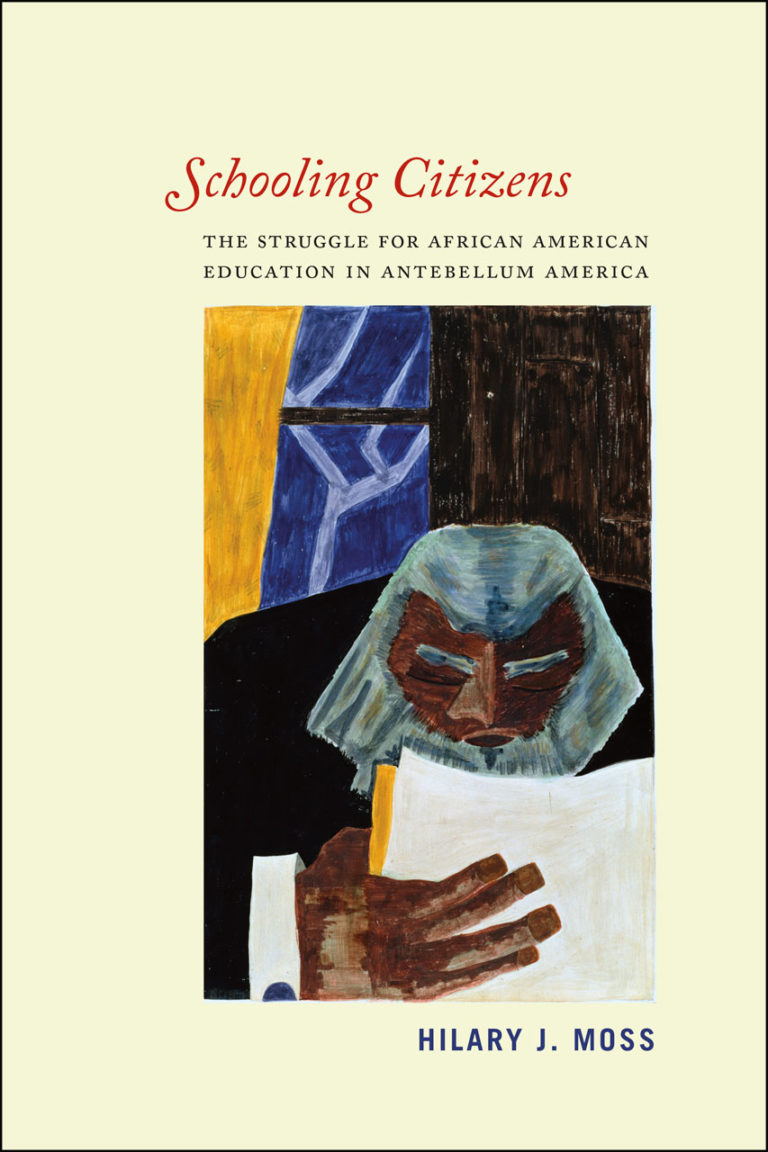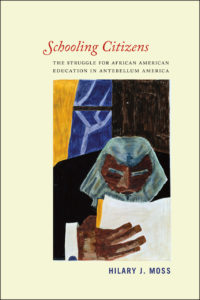The Myth of Universal Education

In 1849, Benjamin F. Roberts, an African American shoemaker, filed suit against the Boston School Committee after they refused to admit his five-year-old daughter, Sarah. The court dismissed the case, but Senator Charles Sumner assisted in the appeal and argued unsuccessfully that as citizens, African Americans should have access to public schools. In Schooling Citizens, Hilary J. Moss presents many such examples of educational activism among antebellum African Americans that prefigured a twentieth-century story about citizenship rights, educational inequality, and white resistance to black schools. Long before Plessy v. Ferguson, Moss argues, the Roberts v. Boston case “gave birth to the precedent that segregation in all areas of public life … did not contradict the Constitution” (181).
Their zeal threatened entrenched white power, so African Americans had to be pragmatic about their activism.
In case studies of three antebellum cities—New Haven, Connecticut; Baltimore, Maryland; and Boston, Massachusetts—Moss challenges our assumptions about Americans’ support for universal education. Schooling Citizens explores educational activism among African Americans and describes the link that developed between issues of citizenship and the creation of public school systems. As in the twentieth century, early nineteenth-century African Americans protested taxation without representation, “argued that school segregation irreversibly stigmatized their children,” disagreed about the merits of integrated schools, suffered when white administrators replaced black teachers with white teachers, and continually demanded full citizenship rights (154). Moss argues that although Horace Mann and other education reformers extolled the merits of universal education, their common school rhetoric “tacitly suggested that black people did not need the same education as whites.” For African Americans, “a separate education would serve their subordinate station” (157).
Moss’ examination of newspaper editorials, apprenticeship contracts, help-wanted ads, census records, and petitions for public support of black schools demonstrates the contingency of history. Before the 1830s, white opposition to black education in these major cities was not a foregone conclusion. Bostonians widely read Phillis Wheatley’s poetry; white residents of New Haven applauded the educational thrust of the African Improvement Society (AIS) upon its founding in 1827; and Baltimore employers advertised for literate black laborers. But Moss persuasively argues that white support for black education cannot be interpreted as support for black equality. In Baltimore, free African Americans could not own property, build religious institutions, “enter into contracts,” or bear witness in court (6). They could, however, acquire literacy without facing the types of resistance that came to characterize New Haven and Boston. White Bostonians supported black education insofar as it did not intrude on the spaces they claimed for themselves. When the school committee allocated public funds to build a black school in 1834, for example, they summarily rejected plans to build the school in a white community. A prelude to the struggle against residential desegregation, residents cited a decrease in morality and property values as consequences of living near a black school as if “the city planned to erect a penitentiary or poorhouse, not an educational institution” (142).
The value placed on literacy and education by free antebellum African Americans foreshadowed the attitudes of former slaves after the Civil War. Their zeal threatened entrenched white power, so African Americans had to be pragmatic about their activism. To temper white opposition to black education in Baltimore, for example, some free blacks avoided associating themselves with abolition and highlighted vocational education and its benefits to society as a whole rather than advertising the literary training in their schools (97, 104). In New Haven, John Brown Russworm’s “faith in the mutability of racial prejudice” encouraged the use of moral suasion to counter arguments about black degeneracy. While white Americans pointed to delinquency among African Americans to rationalize inequity, activists like Russworm argued that black people’s “good behavior” made them model citizens (31). African American educational advocates believed that education, as an improving force, would convince white Americans to acknowledge African American citizenship (7, 96). “Education,” Moss writes, “could not empower antebellum African Americans to rise and fall by their own merits when so many other avenues of socioeconomic advancement remained closed to them” (194). Literacy mattered little in a society that restricted black people’s access to occupational opportunities.
A century before the modern civil rights movement, black Americans adopted strategies of “protest and compromise,” “loyalty and deference,” and “agitation and acquiescence” to secure the rights of American citizenship (97, 114). Between 1839 and 1850, for example, black Baltimoreans submitted three petitions to the city council. The first requested that African American property owners be exempted from paying school taxes because of the lack of provisions made for black schools. A few whites admitted the injustice of funding white schools with taxes paid by black property owners, but most did not advocate against the tax. In a second petition, activists asked for financial support for the two privately funded black schools in the city. The third petition requested that black children have access to free public education. Although the petitions garnered support among white residents, each petition failed (118-120).
Moss uses the transition to public oversight for black schools in Boston to illuminate less passive forms of resistance and the disunity among some black educators. In 1816, when the school committee incorporated Belknap Street School into the public school system, African Americans lost autonomy as white school administrators replaced black teachers with white teachers. White Bostonians’ refusal to allow black students to take advantage of public schools for white children led a group of African Americans to call for a boycott of the Belknap School (137). Then, when Thomas Paul Smith petitioned for a black principal instead of supporting the boycott, he suffered extreme repercussions from other members of the black community. Benjamin F. Roberts, “the first school desegregation plaintiff in the nation” and other advocates for desegregation violently attacked Smith for his disloyalty (165).
In the face of gradual emancipation, increased abolitionist activism, African American demands for civil rights, and news of Nat Turner’s revolt, many northern white Americans adopted resistance in lieu of tolerance (19). Moss presents three editorials that condemned interracial efforts to establish an institute for higher learning in New Haven. The editorialist argued that a black college would “sustain assertions that African Americans were American citizens” (37). Moss perceptively posits that the author’s “conflation of black improvement with citizenship, his conception of education as a zero-sum game, and his contention that uplift would thwart black removal would soon become mantras in white diatribes against black schooling” (42-43).
The historical events described in Schooling Citizens foreshadow many subsequent struggles over education and race. “Readers who have benefited from the scholarship of Ronald E. Butchart and James Anderson, among others, who have revealed new complexities in understanding African American education in the South, should garner new insights from Moss’ location of similar issues across the wider geography of antebellum America. Moss clearly demonstrates that adding race to conversations about the history of American education reveals that “inequity was embedded into [public schools] from the start” (190). This well-researched and well-written volume brings together untapped records and a careful analysis of previously underutilized archival materials to reveal the long struggle for black educational equality. It is an important work that forces a reconsideration of America’s commitment to universal education.
This article originally appeared in issue 11.2.5 (March, 2011).
Christina L. Davis, a Ph.D. candidate in the Department of History at the University of Georgia, is completing a dissertation on Reconstruction-era teachers in black schools.
